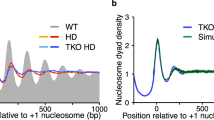Abstract
In eukaryotic cells, DNA is packed into regularly spaced chromatin subunits called nucleosomes. The average distance between nucleosomes (the repeat length) varies in a tissue- and species-specific manner, with values ranging from about 160 to 240 DNA base pairs (bp)1. Thus, it has been recognized that the repeat length could be one of the factors underlying selective gene expression. In cells growing in culture, the characteristic repeat length for that type of cell seems to arise from an immature chromatin structure in which nucleosomes are initially irregularly spaced or are arranged in small closely packed clusters2–5. At present no in vitro system has been described which is capable of reconstituting the mature physiological nucleosome spacing from purified chromatin components. Moreover, neither the factors necessary for spacing nor the reaction mechanism are known. We describe here an in vitro system that can restore the native subunit spacing in rearranged chromatin samples which have irregularly spaced nucleosomes similar to the situation apparent in newly replicated chromatin.
This is a preview of subscription content, access via your institution
Access options
Subscribe to this journal
Receive 51 print issues and online access
$199.00 per year
only $3.90 per issue
Buy this article
- Purchase on Springer Link
- Instant access to full article PDF
Prices may be subject to local taxes which are calculated during checkout
Similar content being viewed by others
References
Kornberg, R. D. A. Rev. Biochem. 46, 931–954 (1977).
Seale, R.L. Proc. natn. Acad. Sci. U.S.A. 75, 2717–2721 (1978).
Levy, A. & Jakob, K. M. Cell 14, 259–267 (1978).
Murphy, R. E., Wallace, R. B. & Bonner, J. Proc. natn. Acad. Sci. U.S.A. 77, 3336–3340 (1980).
Jackson, V., Marshall, S. & Chalkley, R. Nucleic Acids Res. 9, 4563–4581 (1981).
Morris, N. R. Cell 9, 627–632 (1976).
Spadafora, C., Oudet, P. & Chambon, P. Eur. J. Biochem. 100, 225–235 (1979).
Weischet, W. O. Nucleic Acids Res. 7, 291–304 (1979).
Künzler, P. & Stein, A. Biochemistry (in the press).
Germond, J. E., Bellard, M., Oudet, P. & Chambon, P. Nucleic Acids Res. 3, 3173–3192 (1976).
Simpson, R. T. Biochemistry 17, 5524–5531 (1978).
Thoma, F., Kollar, TH. & Klug, A. J. Cell Biol. 83, 403–427 (1979).
Laskey, R. A. & Earnshaw, W. C. Nature 286, 763–767 (1980).
Laskey, R. A., Mills, A. D. & Morris, N. R. Cell 10, 237–243 (1977).
Nelson, T., Hsieh, T-S. & Brutlag, D. Proc. natn. Acad. Sci. U.S.A. 76, 5510–5514 (1979).
Prunell, A. & Kornberg, R. D. J. molec. Biol. 154, 515–523 (1982).
Ruiz-Carrillo, A., Puigdomenech, P., Eder, G. & Lurz, R. Biochemistry 19, 2544–2554 (1980).
Author information
Authors and Affiliations
Rights and permissions
About this article
Cite this article
Stein, A., Künzler, P. Histone H5 can correctly align randomly arranged nucleosomes in a defined in vitro system. Nature 302, 548–550 (1983). https://doi.org/10.1038/302548a0
Received:
Accepted:
Published:
Issue Date:
DOI: https://doi.org/10.1038/302548a0
Comments
By submitting a comment you agree to abide by our Terms and Community Guidelines. If you find something abusive or that does not comply with our terms or guidelines please flag it as inappropriate.



